“How Do We Know?”
Issue #10, March 2020
TABLE OF CONTENTS
Lise Weil, Kristin Flyntz, Krista Hiser, Karen Malpede, Nancy Windheart, Kate Tirion, Hilary Giovale, Sara Wright
Editorial
Manulani Aluli Meyer
Ho’oulu: Our Time of Becoming (Foreword)
Lise Weil
Interview with Manulani Aluli Meyer (Video)
Dorothy Dinnerstein
with Karen Malpede, Naomi Miller and Sarah Karl
Sentience and Survival
Patricia Spears Jones
Flame
Lee Maracle
Nobody Home
Nancy Windheart
Aspen Ways of Knowing
Gillian Goslinga
Interview with Kate Tirion of the Deep Dirt Institute
Leonore Wilson
The Fire That Nearly Took Us
Hilary Giovale
The Blood Knows
Sara Wright
After•Word: “Born Again”
Richard Powers’ The Overstory
Dorothy Dinnerstein
with Naomi Miller and Sarah Karl
Sentience and Survival
Foreword and Gloss by Karen Malpede
Dorothy Dinnerstein’s The Mermaid and the Minotaur had an electric effect in 1976, addressing the question driving a generation. Women are despised by men—and by women—Dinnerstein said, because women birth and become the sole nurturers of infants. We have internalized the female as the feared/revered giver—and hated taker— of life. Dorothy’s solution to the misogynist dilemma was practical: let men take an equal role in caring for babies and children. New generations will grow up feeling inherent equality, in full possession of both nurturant and aggressive sides of themselves. To an extent, she has been proven correct. As more men become intimately involved in childrearing, sexism has been chipped away generation by generation.
But the essential part of Dorothy’s argument, that which concerned our species’ ability to sustain a future on planet earth, got lost in the flurry of praise surrounding Mermaid and was never transmitted to the wider culture. Instead, Dorothy’s prescient fears about looming nuclear and ecological destruction lodged themselves among like-minded thinkers and activists in a vital part of the feminist movement called ecofeminism. For the next decade, ecofeminists met together at conferences and in groups, protested and were arrested over the deployment of nuclear warheads to Europe, the greed of Wall St., the destructiveness of the Pentagon, even as we continued writing, teaching, child-rearing and developing our thoughts. Other women central to this movement who are now dead are Grace Paley, and Barbara Deming.
For the rest of her too-short life, Dorothy, a cognitive psychologist by training, would struggle to surpass the wisdom in Mermaid by addressing a related but evermore vexing question: why can we not see what we must see in order to survive? Sentience and Survival was to be the title of this unwritten book. When she died in 1992, basketfuls of notes were passed on to Naomi Miller, her daughter. Sarah Karl, a friend of both, worked with Naomi to finish the book. They shaped Dorothy’s thoughts into the essay below.
My gloss, which follows the text, reflects the conversations we had, my memories and the questions Dorothy raised, with which I struggle daily. It can be read continuously or the paragraph numbers can be used to refer back to passages in the text itself.
Karen Malpede
“Sentience” is the synonym for ”consciousness” or ”awareness” which to me best connotes the embeddedness of human mind in non-human nature. It expresses the continuity between our own and other animals' abilities to register and respond to events, and suggests the biological function of these abilities—their role in keeping a creature, and/or that creature's species, alive. It refers also to the continuity between human mind's infant and adult modes of organization. It implies the fusion of perceiving, remembering, thinking and feeling; and the interpenetration of articulate and inarticulate, rational and non-rational, mental phenomena. It refers, in fact, to a single process of which all these are aspects.
Human sentience can be described as many-layered and/or many-ringed: its content ranges from conscious and articulate to buried and mute; from focal and clear to peripheral and blurry. At each of these layers or rings, perceiving, remembering, thinking and feeling can all be present. Thus in dreams—forum of the passionate ”unconscious” —abstract thought sends us subtle, witty, even erudite symbolic diagnoses of our own reality. Meanwhile, in science—temple of self-disciplined reason—feeling suffuses (often in ways the scientist cannot explain) hypothesis-formation, observation, analysis, conviction of proof; and hunches, unbidden and unannounced, can suddenly solve problems the scientist has brooded over doggedly for years.5
Sentience is a capacity that (as far as we know) only humans exercise with educated, disciplined, self-watchful intentionality. Learning to use our sentience with more precise intentionality—with more self-discipline and carefully considered purpose—may be the most central task that now confronts the human mind. If it is to go on animating human bodies on this planet, mind (collective sensibility, common understanding, the sentience of ordinary people all over the world) must take in two large features of our contemporary situation. These are features which it cannot take in without reorganizing itself—because allowing ourselves to really know these aspects of our situation would remove our ordinary deafness, untie our voluntary blinders.
One of these features of our situation is that human mind's own products and inventions, and the enactment of certain of its characteristic impulses, are on the verge of annihilating the cumulatively self-created habitat, the old, deep, rich cultural-technological humus, in which human mind itself is rooted. And if this annihilation occurs it will include the wider, deeper, older and far less regenerable life-web within which homo sapiens is a brash, conceited guest, a cancer brainlessly killing its host.
The other feature of our situation with which we must come to terms is that each human individual who fails to embrace some share of our responsibility to prevent this world-murder is thereby helping—without thought—to bring it about. We are no longer free to fiddle while Rome burns: the fire has gotten too large. We are no longer free to allow our human intelligence to be driven by the maddened, frightened part of ourselves—so akin to the desperate bulls of Greek mythology—with whom we are continuous and yet from whom we are so different. We must use our specifically-human intelligence to preserve ourselves—with as much determination as we have previously used it for destruction.
We must force ourselves to think about the unthinkable.
”Thought is free” is an old, popular assertion of mind's integrity. But strangely, people often seem to wish mainly to exert their freedom not to follow their thoughts—and so they become angered by exhortations such as this one. In the past, ”thought is free” stood in defiance of terrifying human force; now it stands in defiance of terrifying historic truth. In the past, what it affirmed was our freedom to think about certain truths, though tyrants were apt to kill us if we talked about them. Currently, people cling to a freedom not to think, a right not to know or talk about, certain truths. What seems apt to kill us is those truths themselves. And surely they seem surer to kill us if we do not think about them than if we do.
Yet this negative inner liberty of mind is defended with a certain cornered desperation— and a certain silent logic. Its obduracy commands a kind of respect, because the facts upon which it refuses to focus are very likely to kill us even if we do think about them.
And in the face of powerful odds that we are indeed close at this moment to the end of earthly life's time, who but oneself has the right to say what one's own mind's central task is?
We all decide for ourselves, in the end, how hard we want to struggle against our own (and each others') death; this holds for Earth's death, as well.
Resentment of the human condition is as human as attachment to it. How hard we each do indeed struggle depends in part on how deeply we want our own and others' lives— and earthly life—to continue. No exhortation to exercise sentience more purposefully and self-reflectively can make us want this more deeply than we each, for our own reasons, want it. But if we do want our collective life to continue after all, the exercise of sentience in more purposeful and self-reflective ways can perhaps make that desire more effectual.3
The human cultural reality, in threatening to kill itself, threatens to kill also the larger organic entity which gave birth to it. This entity, though human cleverness can now guess (as it disappears) at its age and glimpse its complexity, is old and deep beyond human emotional imagination -- and so, it seems, past human empathic grasp.
But though we may not yet be able to see with our hearts the vast interdependency of the earth's community of living things, we can still be challenged: ”Use your head!”
This challenge speaks to that propensity for introspection, that actively self-watchful interest in one's own mental life, which is part of our humanness. It demands that people thinkfeel-out the meaning of our own denial and apathy: our own lack of interest in the question of just how substantial is the threat of universal organic death. Our situation itself calls upon us to examine our strange ability to deny that there is any such threat—and yet at the same time to take it for granted that the earth's doom is sealed… so firmly sealed, indeed, that there is no point in dwelling upon the matter.
What our situation now dares us to do is this: to face the proposition that some part of each of us assents to the prospect of human reality's demise; to consider why this may be the case; and, finally, to ask ourselves whether that part which assents is, in fact, more massive, more weighty, than the part of each of us which rises up in grief and rage against this prospect. Importantly, we must consider the possibility that we cannot tell which of these impulses is more massive, since these two parts have so far managed, in most of us, to avoid contact with each other.
What this challenge says is ”Listen to your heart!” It calls upon us to feelthink-out how deeply, on balance, we do now choose nothingness over life, or vice versa. It dares us to find the part of the self that hates the world—and living as a human within it; and then to bring it face-to-face with the rest of our self. There is another part of us that is willing to put up with human life's ambiguities, terrors, nauseas and humiliations, its cruelties and mortal griefs, for the sake of the astonishments and splendors and delights; for the flexible range—from cosmic to cobweb-frail—of its insights and triumphs and comforts and skills; for its hilarity and its brilliance; for its animal poetry. 1
The likelihood which we have brought upon ourselves and the Earth comes in the adolescence, so to speak, of our species. It comes at the stage that in the individual marks the volatile, scary, inarticulate border between childhood and adult maturity. For humanity as a whole, the present historical moment constitutes precisely such a border: the contemporary swell of socially pooled information about physical reality (and the possibilities of its manipulation) and about our own evolution, history and place in nature, puts humanity as a whole at an edge as volatile and as poorly self-understood as adolescence is for the individual.4
The suicide and murder we toy with now, furthermore, expresses an adolescent failure of nerve at the vision of this freedom, this responsibility; an adolescent rage at our mortal interdependence with each other (whom we do not necessarily love) in the absence of parental arbitration and protection. We are toying—as adolescents often do —with an assertion of our right and power to dispose of our own existence. But our species-wide enactment of this fit of infantile-omnipotent adolescent pique toys also with wider reality—which, like adolescents, we arrogantly regard as the mere furniture or backdrop of our own existence.
Still, we are a kind of animal that can see and say this about itself. We have observed that organic entities—from individual plants and animals to empires and species—have life-cycles, grow old, become extinct. We can assume that humanity, and each of the earth's community of living things, will die a different death someday if our threat to them is now averted. So we may after all decide collectively what a suicidally-inclined adolescent—in a rage against parents, self and life—might well decide, at the last minute, alone: that the furniture of our existence is too lovely to be junked, and our home too precious to be blown up, and that we ourselves as a species are far too young to die. We might decide that there's always time to die later.2
Choosing to live, an adolescent might then examine her or his own identity: walk around it, picking out its flaws, jewels, and at its identifying characteristics that show ”This is me, and no one else.” This self-appraisal, which marks such a key transitional moment in the individual human life, is what allows the person to move on into adulthood, taking responsibility for her or his own actions. If we did this as a species, what would we find?
The central biological asset of our species, it seems, is the neural capacity for intellectual competence with which each intact human infant is born. This capacity refers to (reflects; was evolved in relation to) a particular environmental setting—just as our eyes refer to the light, and our lungs to the air, of the realm within which they evolved. The setting to which this capacity for intellectual competence refers is a dense social fabric of communication and information and learned technique: the humanly created milieu we call culture. We are organically ready at birth to be introduced into it (in the course of a long infancy) by welcoming and intensely nurturing adults.
Our physique long ago evolved to fit and foster a life of articulate, playful, inventive, tool-using, artifact-dependent, experience-pooling, past-remembering, future-anticipating competence. Upon it our crucial ”bets,” in evolutionary terms, were long ago placed. It has succeeded well in keeping us alive among the earth's creatures.
Too well, it now appears. For a long time quite slowly, then faster and faster, and recently like a mushrooming cancer, this competence of ours has established and deepened its dominion over those other creatures. By now their very existence is in our hands: the news with which that intelligence of ours is now confronted is that it has generated and set loose in our midst the power to wipe out the whole of the humanly-created milieu to which our large-brained bodies refer—and all of these bodies, and all of this planet's immensely older and slower-growing life. And it has not even begun to muster realistic ways of leashing that power.
But we need not necessarily throw up our hands in despair; our inability to leash our power is a paralysis of our core talent. We are caught in an eerie fecklessness of our judicious intelligence. This paralysis might be temporary, this fecklessness reversible. We need to try to understand the failure of our intelligence to serve the modest survival function for which it seems originally to have evolved. It is not, of course, a talent which magically detects every threat to our survival, or which guarantees that, knowing of such a threat, we will always prove competent to avert it. It guarantees only that, warned, we can make knowledgeable, imaginative, collaborative efforts—humanly responsible efforts—to keep ourselves and each other alive.
If anything can break through people's present stupefaction—short of the catastrophe for which they seem to be, blindly, waiting—it can only be some burst of self-insight into the reasons for the trance. There would need to be some self-confrontation of human sentience with its own evasion and cowardice; its own soft spots, self-deceits and unresolved ambivalence. Our sentience would need to self-diagnose its own failure, and embrace the function for which it presumably evolved: survival.7
We do not expect our species to exist forever. But it is unworthy of us to die in the way we're threatening to die: blindfolded, blustering, callow, lying to each other and ourselves.
Are we really doomed to kill ourselves off at this point, in this cowardly dishonest way, in a communal fit of pique with the human condition? Are we really incapable of the breadth of view—the collective courage—to grow up? Will we not live until we are mature enough to greet the eventual end of human time with open eyes, ripe enough as a species to meet it as old individuals among us have all along been able to meet the end of personal time—not rushing, angry and blind, to meet death halfway, but calmly, with whole hearts?6
We need to explore the host of conditions that place human beings at risk, due to the peculiar place of human intelligence in nature. First and foremost we need to examine the inarticulate reasons for our refusal of human responsibility, for the withdrawal of our intelligence from its most fundamental societal and biological task. It is our failure, as a species, to stay with this task that threatens to end the human adventure. We need to explore these difficulties—in the hope that confrontation with them may after all break through the eerie calm and the loud busy-ness with urgent trifles, which now blanket people's loving anger and grief, muffle their sensible terror. A meeting is necessary— between the part of our collective consciousness and of each self that wants the world to live and the (often split-off) part that would rather die than grow up: the part that moves, willing, toward the end of all human becoming: toward the death, right now, of earthly life.8
***
A Gloss on the Text with Memories of Dorothy
(1) To be in Dorothy’s presence was to feelthink. She dressed in caftans sewn from bedsheets, literally, long flowing cotton things with tiny, repetitive patterns. She was beautiful always without makeup, wiry, dark hair gone astray, full lips, sparkling green eyes. She was sensuous. In our ecofeminist world, love of sex was expected, accepted, encouraged, stories of lovers shared, reveled in. Love of children, too, of the sensuousness of pregnancy, birthing, nursing, motherhood.
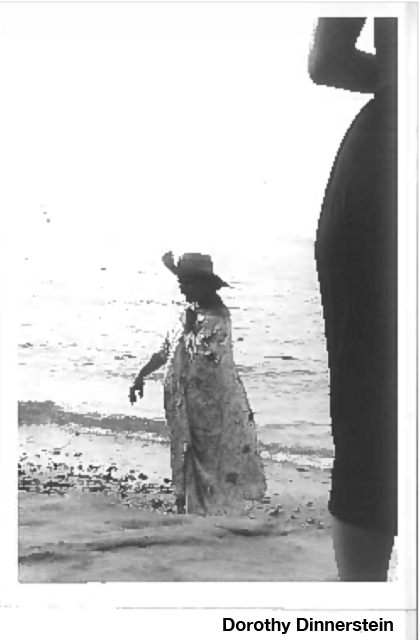 When I became pregnant, Dorothy took me aside and whispered as if sharing a secret passed down through the ages, “This is the best time for creativity. You are so busy making life you won’t give a damn what anyone says about your work.” She was channeling ancient gynaecratic wisdom, passing it on.
When I became pregnant, Dorothy took me aside and whispered as if sharing a secret passed down through the ages, “This is the best time for creativity. You are so busy making life you won’t give a damn what anyone says about your work.” She was channeling ancient gynaecratic wisdom, passing it on.
Rereading Dorothy’s essay in 2020, I realize how closely we remain connected, though she died in 1992 and in the last four years of her life I saw her rarely. How deeply our long conversations penetrated me becoming part of my work to this day. Many of our most intimate and serious conversations were had while we side stroked together for miles in Long Island Sound. Our shared consciousness was born in that water, as we spoke slowly back and forth, working arms and legs in deliberate unitary rhythm, our eyes level, just out of the salt sea, looking into each other.
(2) Dorothy understood: the minute the atomic bomb was dropped, humanity was doomed. It was only a matter of time. Unless, of course, we could bring ourselves to think about our doom. I had been born in the summer of the bomb and a similar understanding came into the world with me. I was taught to hide under my desk, hands over my head, as children today are taught to hit the ground, or barricade themselves in closets in futile, terrifying drills against “active shooters.” The nation had gone mad. It has not returned to sanity since.
(3) Dorothy loved the theater I made. At her country house, one night, under a full moon, near the sea, she asked me to read out-loud my new play, Sappho & Aphrodite, to an assembled group of women friends. Then we danced underneath the moon and after that many among us partnered off to make love through the night. Heathens, pagans, goddess worshippers, it was a group named Demeter’s Daughters, who also got ourselves arrested in various peace actions. Dorothy had a plan to stick toothpicks covered with magic glue into the keyholes at the Stock Market so the doors could not open and the morning bell could never be rung but we used our bodies only. Dorothy sat in front of the massive doors, “Why don’t you go home and play the flute,” she admonished the brokers trying to step over her to get in. I, six months pregnant, did the press conference: “It is safer to be here than sitting at home with my unborn child waiting for the bombs to fall.” I sat next to Dorothy on the arrest bus. She had her mesh bag of peppers and cucumbers and a small serrated knife. She sliced vegetables to be passed around. “She’s armed and dangerous,” an officer said, and, then, to me, “you are pregnant, you might have gotten hurt.” “Who would have hurt me?” I asked. We all laughed. There are moments when something seems possible, for a fraction of a second, for a moonlit night, when the strictures that separate, control and mete out our collective doom fall away.
(4) We did not know, then, about the Koch Bros, Exxon Mobil and the others, their lies for decades about the CO2 emissions from which they earn enormous profit, subsidized with tax dollars, their creation of a climate-denial culture, their take-over of the Republican Party, all for intentional extraction of earth’s resources. Dorothy grew up in a progressive Jewish family. Her people were communists; she was too smart to be a Stalinist, but she understood thievery by the kleptocracy. Her father had been an electrical engineer who lost his business in the Great Depression and died not long after, a bookkeeper at his brother-in-law’s junkyard. My father grew up on relief, eating canned prunes and wearing a hideous purple sweater; he died at forty-four of cancer, after the army, after a spectacular rise into the solid middle class as vice president of a chemical company, a climb that poisoned and killed him. One day at a pond, Dorothy and I sat in the shadows among the reeds, and watched a group of teenage boys walk past dropping coke cans and other litter. “What do you suppose they think they are doing,” Dorothy asked, incredulous. She wanted to know how they could not understand they were wounding the life source, and endangering themselves. This was what she wondered at: unthinking yet willful destruction—the adolescent stage of human sentience in which we are trapped.
(5) Dorothy convened a women’s dream group: Eve Merriam, playwright and children’s book author; Sybil Claiborne, short story writer; Ann Snitow, feminist theorist, and me. We all had dreams in which the dead spoke, and animal dreams, also with voice. These were heraldic. We all dreamt of living spaces, of being confined in trashed and unlivable spaces or of large, inviting homes revealing room after room, or of having nowhere to be; these interior images of external surroundings were mirrors of the psyche’s journey as it sought to create. Becoming conversant with and sharing our unconscious in this way and also having to attend to the innermost being of others had a ritual-like, liberatory effect, enough so that we met together for several years. I, now the sole surviving member, carry what I learned. I still have similar recurring dreams and I still use our collective insights in my work.
(6) We marched on the Pentagon. A new mother, I expressed my breast milk into the toilets in the Pentagon underground mall. We camped out in front of the nuclear base near Seneca Falls (with my three-year-old) where the Trident missiles would have left for deployment in Europe. The local men met us marching over a bridge in the town of Waterloo, with American flags on poles that had been sharpened to use as lances. I had my child, in a red, white, and blue-striped bathing suit, on my shoulders; we blended into the crowd. Most of the women sat down on the bridge and fifty-four were arrested and locked in a schoolhouse for several days. Not the armed men.
What if Dorothy’s brand of passionate love for the World’s creatures and people, her delight living in nature, her out-sized compassion, her fierce resistance to war and violence, what if the breadth of her intellect, her insistent, nagging unanswered, perhaps unanswerable questions, had dominated the feminism of the 80’s and persisted to infuse feminist thought now? Dorothy challenged human sentience to emerge from its stuckness in adolescent simplicities, a certain false omnipotence coupled with a dangerous self-destructive denial of death, to become something akin to a wavelike, shimmering breakthrough to unified feelthink-emboldened consciousness. She did not know how this could be accomplished, only that it must. Direct action was part of the plan. So was sensuousness, fluid and accepting. So was art, song, dance, poetic expression of idea. This was our ecofeminism.
(7) Dorothy and I had in common frequent debilitating depressions. When she writes of a “burst of self-insight,” I believe she refers to the energies we sensed might be released by the inner clashing of our mutual addictions to sentient joys and self-annihilation. When she was joyful she was ever so. No one exalted in nature, sexuality, intellectual life, or friendship more than she.
(8) How do we thinkfeel what we must know? First, Dorothy would agree, we must face our grief at what we’ve done to the world in which we live. Grief demands acceptance. One can anticipate love, work toward success, decry disappointment, protest unfairness, but there is nothing to be done with grief. Grief immobilizes, we say. Grief washes over. Grief destroys what was, wrenching the self away from the known. Grief has its way with us. We can do nothing to it. Grief is impregnable, cannot be moved, gone around, under, or over. Grief sits like a stone in the heart. Weighing one down, stopping time. There is nothing any more before or after. No memory that does not come to this. Hope or desire reveal themselves to be what they always were, illusion, futile, impossible, cruel. Only grief is. If we can stand and tolerate, wait—and we all do or will—of necessity, of course, we will all lose if nothing else our own lives. We stare grief in the face. The more we dare love, the more we shall lose. Stand like a mountain (Tadasana), they say in yoga, and in chi gong, like a mountain. Or be felled like a tree, or lunge like an animal caught in the claws of a trap, pulling its own leg off. Stand like a mountain. Nothing here feels like choice. But if one has to choose, then, obviously, stand like a mountain, be pummeled by grief. If we know our world is dying, every living thing imperiled, stand like a mountain, in time, too, you will crack, erode, split, be worn, come to nothing. Be that awareness. Nothing any more to be done. Grief defies doing. If we all, if we could, if we were able to stand in our grief, an enormous silence might fall across the world. All the creatures would breathe a sigh of relief, all of plant life, the sea, every leafbugalgeabloom still for an instant: “See. They see, they know, they see it too. They have been stopped by the grief of what they have done. They are still. Standing still, with us now.”
Then, feelthink will emerge; we will come to our senses in a spectacular spasm of recognition-loosening desire.
Karen Malpede
*A portion of this article first appeared in Open Democracy, Transformations.
About the Authors
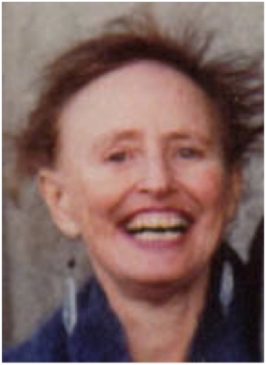
Dorothy Dinnerstein attended Brooklyn College and earned her Ph.D. in experimental psychology from The New School for Social Research. She taught at Rutgers University-Newark, where she co-founded the Institute for Cognitive Studies with Solomon Asch. The Mermaid and the Minotaur: Sexual Arrangements and Human Malaise was published in 1976. Dorothy died in a car accident in 1992.
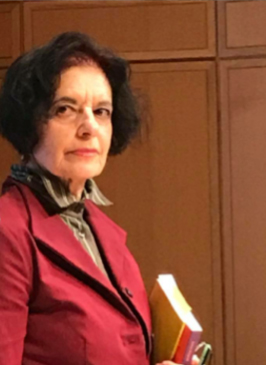
Karen Malpede is a writer, playwright and director and co-founder of Theater Three Collaborative. Her work includes Plays in Time: The Beekeeper's Daughter, Prophecy, Another Life, Extreme Whether, and Other Than We, which premiered at LaMama ETC in New York on November 18, 2019, and is published by Laertes.
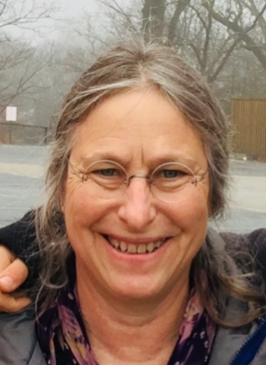
Naomi Miller is a retired Professor of Psychology at Sussex County Community College and a consultant on diversity, equity and inclusion for social service agencies and academic institutions.
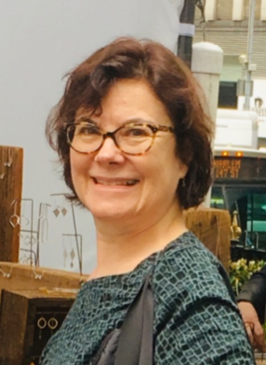
Sarah Karl is a psychologist in Student Affairs at Rutgers New Jersey Medical School, Newark, and has a private practice in Montclair, New Jersey. She is also a practitioner of Insight Meditation.
To comment on this article, please click here.
Copyright © 2014-2021 Dark Matter: Women Witnessing - All rights reserved to individual authors and artists.
Email: Editor@DarkMatterWomenWitnessing.com
Please report any problems with this site to webmaven@DarkMatterWomenWitnessing.com
